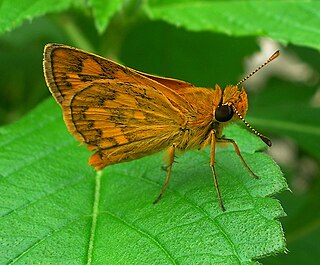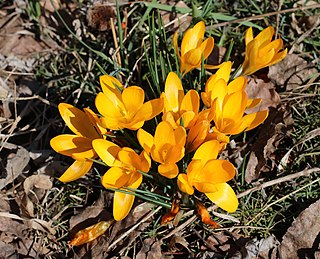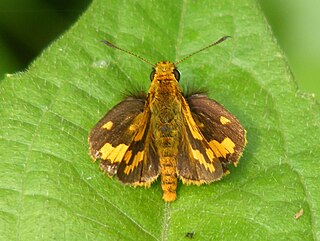
The kinkajou is a tropical rainforest mammal of the family Procyonidae related to olingos, coatis, raccoons, and the ringtail and cacomistle. It is the only member of the genus Potos and is also known as the "honey bear". Though kinkajous are arboreal, they are not closely related to any other tree-dwelling mammal group.

Aspergillus flavus is a saprotrophic and pathogenic fungus with a cosmopolitan distribution. It is best known for its colonization of cereal grains, legumes, and tree nuts. Postharvest rot typically develops during harvest, storage, and/or transit. Its specific name flavus derives from the Latin meaning yellow, a reference to the frequently observed colour of the spores. A. flavus infections can occur while hosts are still in the field (preharvest), but often show no symptoms (dormancy) until postharvest storage or transport.

Potanthus confucius, the Chinese dart or Confucian dart, is a species of butterfly belonging to the family Hesperiidae. They are found from Sri Lanka and India to China and Japan and down to Sumatra and Java in Indonesia. Some museum specimens have also been reported to be from Palawan in the Philippines, but due to the absence of the species in Borneo, it is possible that these were mislabeled or misidentified.

Potanthus pallida, commonly known as the pallid dart or pale dart, is a species of butterfly in the family Hesperiidae found in India.
Potanthus palnia, commonly known as the Palni dart, is a butterfly belonging to the family Hesperiidae found in India and Indochina.

Potanthus pava, commonly known as the Pava dart or yellow dart, is a butterfly belonging to the family Hesperiidae. It is found from southern India to central China, Taiwan, Malaysia, the Philippines, and Sulawesi, Indonesia.

Potanthus pseudomaesa, commonly known as the Indian dart, is a species of butterfly belonging to the family Hesperiidae. Iit is found in India and Sri Lanka. The larvae are known to feed on Axonopus compressus.

Oncom is one of the traditional staple foods of the Sundanese cuisine of Indonesia. There are two kinds of oncom: red oncom and black oncom. Oncom is closely related to tempeh; both are foods fermented using mold.

Potanthus is a large genus of skipper butterflies. They are commonly known as darts. They are found from South Asia to East Asia, and down to maritime Southeast Asia. It includes about 35 species, all of which look very similar to each other and are often only reliably identifiable through the examination of the male genitalia.

Crocus flavus, known as yellow crocus, Dutch yellow crocus or snow crocus, is a species of flowering plant in the genus Crocus of the family Iridaceae. It grows wild on the slopes of Greece, former Yugoslavia, Bulgaria, Romania and northwestern Turkey, with fragrant bright orange-yellow flowers. It is a small crocus (5–6 cm, despite the names of some cultivars, compared to the giant Dutch crocuses. Its cultivars are used as ornamental plants.

Amphidromus flavus is a species of air-breathing land snail, a terrestrial pulmonate gastropod mollusc in the family Camaenidae.

Potanthus serina, the large dart, is a species of butterfly of the family Hesperiidae. It is found on the Andamans, as well as in southern Burma, Singapore and the Philippines. The habitat consists of grassy areas and mangrove areas.
The Liber Flavus Fergusiorum is a medieval Irish text authored by the Ó Fearghuis, an Irish medical family of Connacht who were hereditary physicians to the Irish nobility.

Potanthus niobe is a species of skipper butterflies endemic to the Philippines. It contains two subspecies:

Potanthus omaha, commonly known as the lesser dart, is a species of skipper butterflies. It is found in Australia, Indochina, Malaysia, Singapore, the Philippines, India and Indonesia. It includes the following subspecies:

Phaius flavus is a species of orchid in the genus Phaius described by John Lindley in 1831. It is widespread across much of Asia as well as New Guinea, New Caledonia, Samoa and Vanuatu.

Aspergillus parasiticus is a fungus belonging to the genus Aspergillus. This species is an unspecialized saprophytic mold, mostly found outdoors in areas of rich soil with decaying plant material as well as in dry grain storage facilities. Often confused with the closely related species, A. flavus, A. parasiticus has defined morphological and molecular differences. Aspergillus parasiticus is one of three fungi able to produce the mycotoxin, aflatoxin, one of the most carcinogenic naturally occurring substances. Environmental stress can upregulate aflatoxin production by the fungus, which can occur when the fungus is growing on plants that become damaged due to exposure to poor weather conditions, during drought, by insects, or by birds. In humans, exposure to A. parasiticus toxins can cause delayed development in children and produce serious liver diseases and/or hepatic carcinoma in adults. The fungus can also cause the infection known as aspergillosis in humans and other animals. A. parasiticus is of agricultural importance due to its ability to cause disease in corn, peanut, and cottonseed.
This page is based on this
Wikipedia article Text is available under the
CC BY-SA 4.0 license; additional terms may apply.
Images, videos and audio are available under their respective licenses.















